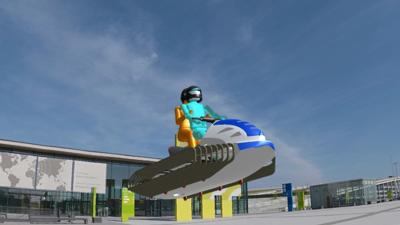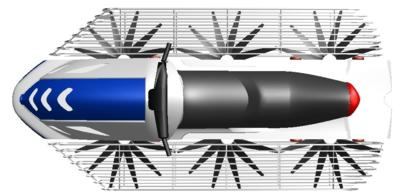Thu, Jan 20, 2022
Horizon Aero and Blainjett to Demonstrate Flying Prototype of Level-Flight, Tailless eVTO
"Hoverbikes" seem to be the fad of the year, amid a rapidly growing aerial mobility market inundated with every possible combination of tadpole inspired fuselage designs packed with as many rotors as the battery packs can stand.

Those smaller, hungrier startups have to differentiate themselves from the pack somehow, and if recent announcements are pointing north, then being the first to market a flying motorcycle is a reliable way to get eyes on a project. Sure, much like terrestrial motorcycles they forego a measure of wind protection, crash survivability, and passenger comfort, but marketers know that purely logical purchase decisions are few and far between.
The newest would-be addition to the flying motorcycle competition is the result of small aeronautical startup Blainjett Aviation and relatively unknown Horizon Aeronautics. Blainjett received some notice in 2019 when it revealed its own concept for rotorcraft propulsion, patented as "Dynamic-Variable-Pitch Propeller Technology' (DVP), a tech that Blainjett says allows a variety of vertical takeoff rotorcraft to greatly improve their efficiency in flight. The company's initial proof of concept reportedly showed a 75% to 125% improvement in helicopter top speed, but Blainjett aims to demonstrate their tech along non-traditional aircraft in the AAM market. Blainjett's system reportedly avoids drawbacks of other thrust-vectoring systems while countering the dissymmetry of lift inherent to their designs, but since its introduction there have been few takers - until now.

Blainjett announced the newest application of its "novel lift-rotor configuration" while working on Horizon's Hoverbike concept. Closer to an aerial jet-ski than a motorcycle, the propellers underneath the body of the bike allow for vectored thrust in forward flight without the use of a tail rotor. The aircraft leverages Blainjett's DVP to allow its rotor pitch to adjust itself throughout half of its arc, theoretically keeping the aircraft level while in flight. DVP allows for the bike to use fewer rotors to achieve the results of multiples placed along different lines of thrust, as well as more efficient, larger blades. The first functional prototype using the patent-pending rotor design is expected to take flight by year's end. If successful, Blainjett will continue to provide its expertise in its hemispherical rotor application to interested parties throughout the AAM industry.
More News
How To Get A Story On Aero-TV News/Feature Programming How do I submit a story idea or lead to Aero-TV? If you would like to submit a story idea or lead, please contact Jim Campbel>[...]
“As the excitement builds for the world of flight returning to Oshkosh in 2026, we wanted to ensure that advance tickets are available for those who enjoy giving AirVenture t>[...]
North Atlantic High Level Airspace (NAT HLA) That volume of airspace (as defined in ICAO Document 7030) between FL 285 and FL 420 within the Oceanic Control Areas of Bodo Oceanic, >[...]
Also: Cosmonaut Kicked Out, Airbus Scales Back, AF Silver Star, Russian A-60 Clobbered A Samaritan’s Purse humanitarian flight was hijacked on Tuesday, December 2, while atte>[...]
Also: IAE Acquires Diamond Trainers, Army Drones, FedEx Pilots Warning, DA62 MPP To Dresden Tech Uni The danger to the flight training industry and our future pilots is clear. Dona>[...]
 ANN FAQ: Contributing To Aero-TV
ANN FAQ: Contributing To Aero-TV Aero-News: Quote of the Day (12.10.25)
Aero-News: Quote of the Day (12.10.25) ANN's Daily Aero-Term (12.10.25): North Atlantic High Level Airspace (NAT HLA)
ANN's Daily Aero-Term (12.10.25): North Atlantic High Level Airspace (NAT HLA) Airborne 12.08.25: Samaritans Purse Hijack, FAA Med Relief, China Rocket Fail
Airborne 12.08.25: Samaritans Purse Hijack, FAA Med Relief, China Rocket Fail Airborne-Flight Training 12.04.25: Ldg Fee Danger, Av Mental Health, PC-7 MKX
Airborne-Flight Training 12.04.25: Ldg Fee Danger, Av Mental Health, PC-7 MKX




